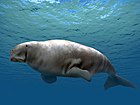
The Sirenia, commonly referred to as sea cows or sirenians, are an order of fully aquatic, herbivorous mammals that inhabit swamps, rivers, estuaries, marine wetlands, and coastal marine waters. The extant Sirenia comprise two distinct families: Dugongidae and Trichechidae with a total of four species. The Protosirenidae and Prorastomidae families are extinct. Sirenians are classified in the clade Paenungulata, alongside the elephants and the hyraxes, and evolved in the Eocene 50 million years ago (mya). The Dugongidae diverged from the Trichechidae in the late Eocene or early Oligocene.
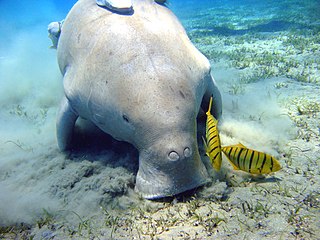
Dugongidae is a family in the order of Sirenia. The family has one surviving species, the dugong, one recently extinct species, Steller's sea cow, and a number of extinct genera known from fossil records.

The Desmostylia are an extinct order of aquatic mammals native to the North Pacific from the early Oligocene (Rupelian) to the late Miocene (Tortonian). Desmostylians are the only known extinct order of marine mammals.

Meniscoessus is a genus of extinct multituberculates from the Upper Cretaceous Period that lived in North America.
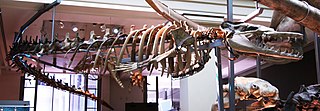
Basilosaurus is a genus of large, predatory, prehistoric archaeocete whale from the late Eocene, approximately 41.3 to 33.9 million years ago (mya). First described in 1834, it was the first archaeocete and prehistoric whale known to science. Fossils attributed to the type species B. cetoides were discovered in the United States. They were originally thought to be of a giant reptile, hence the suffix "-saurus", Ancient Greek for "lizard". The animal was later found to be an early marine mammal, prompting attempts at renaming the creature, which failed as the rules of zoological nomenclature dictate using the original name given. Fossils were later found of the second species, B. isis, in 1904 in Egypt, Western Sahara, Morocco, Jordan, Tunisia, and Pakistan. Fossils have also been unearthed in the southeastern United States and Peru.

Halitherium is an extinct dugongid sea cow that arose in the late Eocene, then became extinct during the early Oligocene. Its fossils are common in European shales. Inside its flippers were finger bones that did not stick out. Halitherium also had the remnants of back legs, which did not show externally. However, it did have a basic femur, joined to a reduced pelvis. Halitherium also had elongated ribs, presumably to increase lung capacity to provide fine control of buoyancy. A 2014 review presented the opinion that the genus is dubious.

Sirenia is the order of placental mammals which comprises modern "sea cows" and their extinct relatives. They are the only extant herbivorous marine mammals and the only group of herbivorous mammals to have become completely aquatic. Sirenians are thought to have a 50-million-year-old fossil record. They attained modest diversity during the Oligocene and Miocene, but have since declined as a result of climatic cooling, oceanographic changes, and human interference. Two genera and four species are extant: Trichechus, which includes the three species of manatee that live along the Atlantic coasts and in rivers and coastlines of the Americas and western Africa, and Dugong, which is found in the Indian and Pacific oceans.
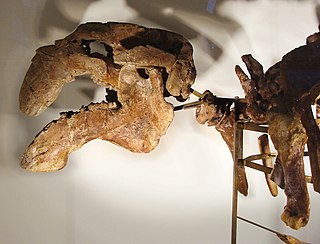
Eotheroides is an extinct genus of Eocene sirenian. It is an early member of the family Dugongidae, which includes the extant dugong. Fossils have been found from Egypt, India, and Madagascar. Eotheroides was first described by Richard Owen in 1875 under the name Eotherium, which was replaced by the current name in 1899.

Metaxytherium is an extinct genus of dugong that lived from the Oligocene until the end of the Pliocene. Fossil remains have been found in Africa, Europe, North America and South America. Generally marine seagrass specialists, they inhabited the warm and shallow waters of the Paratethys, Mediterranean, Caribbean Sea and Pacific coastline. American species of Metaxytherium are considered to be ancestral to the North Pacific family Hydrodamalinae, which includes the giant Steller's sea cow.
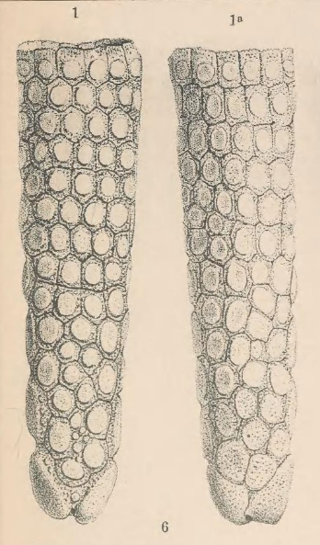
Lomaphorus is a possibly dubious extinct genus of glyptodont that lived during the Pleistocene in eastern Argentina. Although many species have been referred, the genus itself is possibly dubious or synonymous with other glyptodonts like Neoslerocalyptus from the same region.
Plesiocetus is a genus of extinct rorquals found worldwide. It has had a chequered taxonomic history, having served as a wastebasket genus for a handful of mysticete species.

Hyaenodonta is an extinct order of hypercarnivorous placental mammals of clade Pan-Carnivora from mirorder Ferae. Hyaenodonts were important mammalian predators that arose during the early Paleocene in Europe and persisted well into the late Miocene.

Miosiren is an extinct genus of manatee from the Early Miocene of southeastern England (Suffolk) and Antwerp, Belgium.
Anomotherium is an extinct genus of manatee that lived in the shallow seas of what is now northern Germany. Its closest relative is Miosiren. Fossils of the genus have been found in the Bohlen and Doberg Formations of Germany.
Potamosiren is an extinct genus of manatee from the Middle Miocene (Laventan) Honda Group of Colombia.

Lentiarenium was an early sea cow from the Late Oligocene (Chattian) Linz-Melk Formation of Austria. Known since the mid 19th century, Lentiarenium was long considered to be a species of Halitherium until a 2016 analysis showed it to be distinct.
Italosiren is an extinct genus of early dugong from the Early Miocene (Aquitanian) Libano Formation in Northern Italy.

Crenatosiren is an extinct genus of dugongid sirenian known from the late Oligocene (Chattian) of Florida, North Carolina, and South Carolina. The type and only known species is Crenatosiren olseni.

Stegosiren was an early sea cow from the Middle Oligocene of South Carolina, US. It shows a stage of halitheriine evolution more derived than that of the Old World early Oligocene Eosiren imenti and Halitherium schinzii.
















